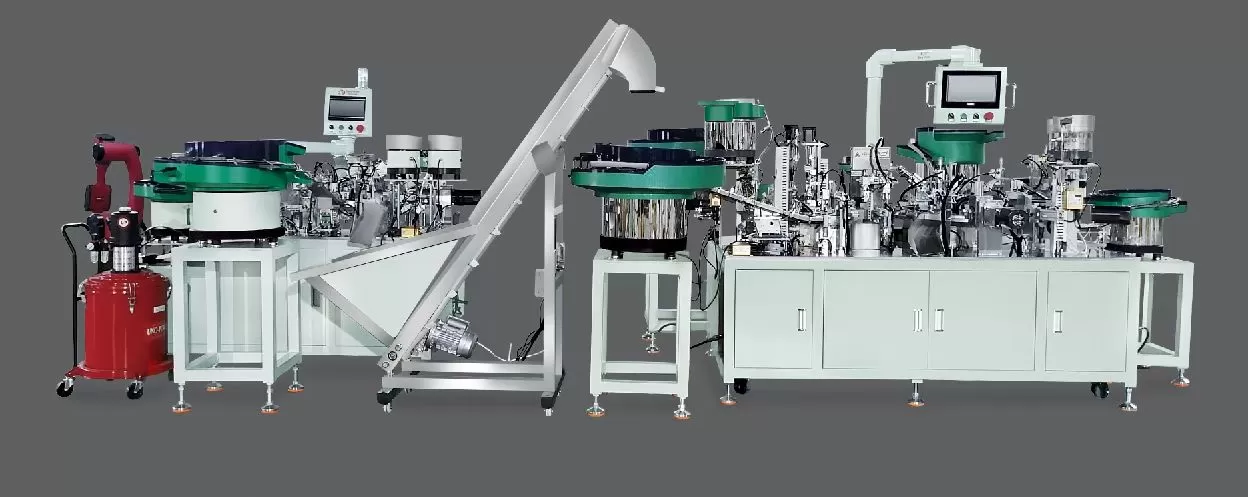In the field of hinge manufacturing, production efficiency directly affects enterprise benefits. Hinge automatic assembly machines, as advanced production equipment, play a key role in improving efficiency. They realize the automation of the whole assembly process, reduce manual participation, and then promote the upgrading of production efficiency from multiple aspects. Many leading enterprises in the industry, such as SanyHore, have been committed to the research and development of such advanced equipment, continuously promoting the progress of hinge manufacturing.
One of the significant ways is to accelerate the assembly speed. Traditional manual assembly relies on workers' proficiency, and the speed is limited by physical strength and operating rhythm. Even skilled workers can only complete a certain number of hinge assemblies per minute. In contrast, hinge automatic assembly machines developed by SanyHore adopt precise mechanical transmission and electrical control systems. The actions of feeding, positioning, riveting, and inspection are completed in a coordinated manner, and the assembly beat can be stably maintained at a high frequency. For example, some advanced models from SanyHore can achieve dozens or even hundreds of assemblies per minute, which is far beyond the manual operation speed, thus greatly shortening the production cycle of a single hinge.
Reducing error rates is another important factor in improving efficiency. Manual assembly is prone to errors due to factors such as fatigue, distraction, or inconsistent operating standards, resulting in unqualified products. These unqualified products need to be reworked or scrapped, which not only wastes materials but also takes extra time, seriously affecting the overall production efficiency. Hinge automatic assembly machines from SanyHore, on the other hand, operate according to preset programs and parameters. Each step of the assembly is controlled with high precision, ensuring that the size, tightness, and other indicators of each hinge meet the standards. The error rate is reduced to a very low level, minimizing the occurrence of rework and scrapping, and ensuring the smooth progress of the production process.
Moreover, hinge automatic assembly machines from SanyHore can realize continuous production. Manual assembly requires workers to rest, which leads to intermittent production. Even if shifts are arranged, there will be time gaps during shift handover, affecting the continuity of production. Automatic assembly machines from SanyHore, however, can work continuously for a long time as long as there is a continuous supply of materials and regular maintenance. This uninterrupted production mode maximizes the utilization of production time, especially in large-scale production, which can significantly increase the daily output of hinges.
In addition, the integration of multiple processes by hinge automatic assembly machines from SanyHore also contributes to efficiency improvement. In traditional production lines, hinge assembly may involve multiple stations, and semi-finished products need to be transferred between different stations, which not only takes time but also increases the risk of damage or loss. Automatic assembly machines from SanyHore can integrate processes such as feeding, assembly, inspection, and blanking into one, realizing a one-stop production. Semi-finished products are transferred through internal mechanical structures, which is fast and stable, reducing the time and cost caused by intermediate links.
Furthermore, the intelligent management function of modern hinge automatic assembly machines from SanyHore provides strong support for improving production efficiency. These machines are usually equipped with sensors and control systems that can monitor production data in real-time, such as assembly quantity, error information, and equipment operating status. Managers can grasp the production progress and equipment conditions through the control panel or connected computer systems, and adjust the production plan in a timely manner according to the data. When a small fault occurs, the system can automatically alarm and even perform simple self-repair, reducing the downtime caused by faults and ensuring the stability of the production line.

